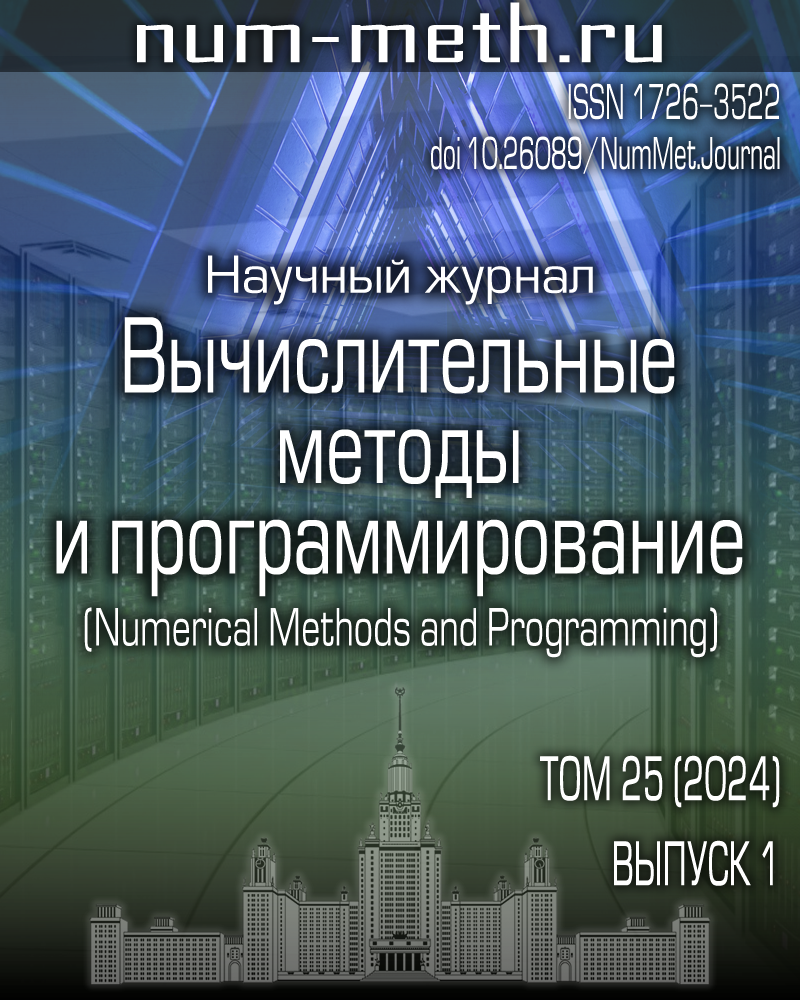|
|
Numerical methods and programming, 2017, Volume 18, Issue 4, Pages 434–446
(Mi vmp891)
|
 |
|
 |
This article is cited in 1 scientific paper (total in 1 paper)
Parallel simulation of kinetic processes by Monte Carlo method (dedicated to the memory of the Chief Theoretician of Cosmonautics academician M.V. Keldysh in the 60th anniversary of the launch of the first artificial sputnik)
M. A. Marchenkoab, T. A. Sushkevichc
a Institute of Computational Mathematics and Mathematical Geophysics of Siberian Branch of Russian Academy of Sciences, Novosibirsk
b Novosibirsk State University
c Keldysh Institute of Applied Mathematics of Russian Academy of Sciences, Moscow
Abstract:
In 2017, the global community celebrates the 60th anniversary of the launch on 4 October 1957 in USSR of the first Earth sputnik, which ushered the space age. The ballistic calculations were conducted on the first production computer “Strela” in the Keldysh Institute. When solving the most complicated problems of creating a “nuclear missile shield” were laid the foundations for new directions in mathematics computational mathematics and mathematical modeling. And in the USSR and the USA simultaneously developed the deterministic and statistical numerical methods. Methods Monte Carlo (MMC) as a tool for direct statistical simulation has been developed in the United States under the Manhattan project to create nuclear weapons. John von Neumann first proposed to use the computers to generate random numbers. In 1949, John von Neumann and Stanislaw Ulam proposed the first algorithm generating pseudo-random values, which was subsequently named MMC and was the basis for the development of the technique of generating pseudo-random numbers using a computer. The development of MMC and the effectiveness of its application always begins with the development of random or pseudo-random numbers, which depends on the class of tasks and the specific structure and architecture of computers. Methods Monte Carlo began to apply on all architectures of computing systems with parallel and distributed computing. Now in the era of superficially dominated by MMC as a result of the simplicity of their implementation. But this simplicity is deceptive. Developed a complex methodological approach on the example of three complicated “big” problems describing spatially inhomogeneous kinetic processes of diffusion, coagulation, and migration of charged particles, systematically discusses the theory of methods and algorithms for MMC and practice implementing them in the format of not just programs, as well as the parallel random number generators, libraries, data processing, control programs, etc., i.e., all the stages of creating a “digital product”. For example, probabilistic models for numerical simulation of the kinetic processes of diffusion, coagulation, and migration of charged particles when the ensembles of trajectories or particles contain 10 in 7-13 degrees of elements, and demonstrated the potential and effectiveness of the MMC to resolve “big” and “complex” tasks not only for the calculation of particular functionals or estimates, but for the whole phase volume of the task. This is the most important achievement that increases MMC's competitiveness with the deterministic finite-difference and grid methods for parallel simulation.
Keywords:
information and mathematical software, kinetic processes, Monte Carlo method, distributed parallel computing.
Received: 09.11.2017
Citation:
M. A. Marchenko, T. A. Sushkevich, “Parallel simulation of kinetic processes by Monte Carlo method (dedicated to the memory of the Chief Theoretician of Cosmonautics academician M.V. Keldysh in the 60th anniversary of the launch of the first artificial sputnik)”, Num. Meth. Prog., 18:4 (2017), 434–446
Linking options:
https://www.mathnet.ru/eng/vmp891 https://www.mathnet.ru/eng/vmp/v18/i4/p434
|

| Statistics & downloads: |
| Abstract page: | 218 | | Full-text PDF : | 173 |
|




 Contact us:
Contact us: Terms of Use
Terms of Use
 Registration to the website
Registration to the website Logotypes
Logotypes








 Citation in format
Citation in format 
